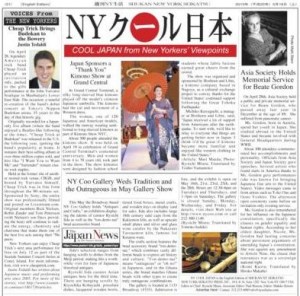Justin’s Japan: Nippon in New York – Heritage at Citi Field, Hatsune Miku and the Joy of Sake
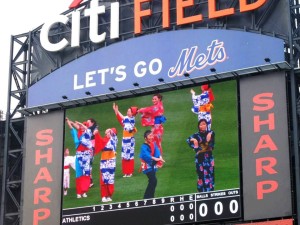
The Japanese Folk Dance Institute of New York will perform at Citi Field’s fourth annual Japanese Heritage Night Aug. 28. (Courtesy of blog.janm.org)
By JQ magazine editor Justin Tedaldi (CIR Kobe-shi, 2001-02) for Examiner.com. Visit his Japanese culture page here for related stories.
As the summer winds fade to fall colors, the weeks ahead are shaping up with these exciting events, ready to be enjoyed both before and after Labor Day.
This month’s highlights include:
Wednesday, Aug. 28, 6:30 p.m.
New York Mets Fourth Annual Japanese Heritage Night
Citi Field, 123-01 Roosevelt Ave.
$23 Promenade Reserved/$37 Pepsi Porch/$63 Baseline Box Silver
Watch the Mets take on the Philadelphia Phillies with a special Japanese Heritage Night pre-game show featuring the Japanese Folk Dance Institute of New York, the Japanese Men’s Choir, taiko and fue master Kaoru Watanabe, and the Spirit Award presentations to important members of the community. Look for fun Japanese activities and games throughout the evening at the special Japanese Heritage Night tables! A portion of the proceeds of all ticket sales made through the special JHN ticket window and through online sales will be given to the Japanese American Association’s Committee on Aging Issues.
Saturday, Aug. 31, 2:00 p.m.
Hatsune Miku Magical Mirai 2013 premiere
Anthology Film Archives, 32 Second Avenue
$20 general admission
In Japan, Hatsune Miku is a phenomenally successful virtual idol that grew out of fan-created songs. With a name meaning “first sound of the future,” she is based on an innovative singing synthesizer software character. This special theatrical release—her first in the U.S. in nearly two years—celebrates the pop Vocaloid’s sixth birthday of by capturing a special commemorative live concert at the Yokohama Area simulcast in both New York and Los Angeles. (For this Examiner’s review of Miku’s previous live film screening in Times Square, click here.)
Sunday, Sept. 1, 5:30 p.m.
J-Summit New York Benefit Concert
The Bowery Electric, 327 Bowery
$15 advance/$18 day of show
Offering a welcoming environment to enjoy music, dance, performance and fashion for all fans and artists, j-Summit New York has created a community focused on the connections and cultural exchanges between New York and Japan through electrifying events. Proceeds for this special benefit concert will contribute to the 2011 earthquake and tsunami relief fund. Bands for the night include Aki, Lust, Red, Iri, Nicole Oliva, Nafsi Groove, and Yuri Bear.
For the complete story, click here.
Justin’s Japan: Nippon in New York — Karaoke Networking, Poisson Piano and ‘Cutie and the Boxer’
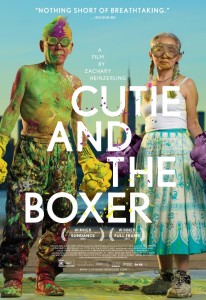
The award-winning documentary Cutie and the Boxer premieres at Lincoln Plaza Cinema and Landmark Sunshine Cinema Aug. 16. (RADiUS-TWC)
By JQ magazine editor Justin Tedaldi (CIR Kobe-shi, 2001-02) for Examiner.com. Visit his Japanese culture page here for related stories.
In the dog days of summer, it’s best to escape the heat in a place that’s cozy and cool. For those into Japanese cultural events, this month offers a diverse selection of music, film premieres and parties—all in the comfort of indoor air conditioning.
This month’s highlights include:
Thursday, Aug. 1, 7:30 p.m.
Young Professionals 2nd Annual Midsummer Matsuri and Karaoke Party
Japan Society, 333 East 47th Street
$10 for corporate and individual members, $15 for non-members
Japan Society’s Young Professionals events provide the opportunity for emerging business leaders from the U.S. and Japan (aged 25-45) to meet people with similar interests, experience programming on timely topics, and network with their peers. Attendees are invited to join for a night of networking, singing, eating and drinking featuring singer and Japanese TV personality Alex York as MC! Yukata and other summer attire are welcome, and admission includes light Japanese food and one drink ticket, cash bar thereafter. Space is limited; for advance registration email youngpro@japansociety.org or call 212-715-1219.
Saturday, Aug. 3, 7:00 p.m.
Asia Society, 725 Park Avenue
$35 members/students/seniors, $40 nonmembers
As part of the closing night presentation of the 36th Asian American International Film Festival, this screening of Our Homeland includes a Q&A with the director followed by an awards ceremony and gala reception featuring chef’s tasting tables and open bar with specialty cocktails sponsored by Rémy Martin. Sent decades ago as a child to North Korea under a repatriation program, Sungho returns to Japan for a temporary medical visit. A wrenching human drama unfolds as his family grapples with why he was ever let go. Under the constant surveillance by an accompanying North Korean official, Sungho and his family reunite again in this sensitive tale inspired by Korean-Japanese director Yang Yonghi’s true family story. Capturing the tender feelings of separation, memory, and belonging, the film also provides a rare glimpse into the life of ethnic Koreans in Japan. Presented in Japanese and Korean with English subtitles.
Friday, Aug. 16
Lincoln Plaza Cinema and Landmark Sunshine Cinema
$13, $13.50
Winner of the Directing Award for U.S. Documentary at the 2013 Sundance Film Festival and a hit at film festivals around the world, this candid New York story explores the chaotic 40-year marriage of renowned “boxing” painter Ushio Shinohara and his artist wife, Noriko. As a rowdy, confrontational young artist in Tokyo, Ushio seemed destined for fame, but met with little commercial success after he moved to New York City in 1969, seeking international recognition. When 19-year-old Noriko moved to New York to study art, she fell in love with Ushio—abandoning her education to become the wife and assistant to an unruly, husband. Over the course of their marriage, the roles have shifted. Now 80, Ushio struggles to establish his artistic legacy, while Noriko is at last being recognized for her own art—a series of drawings entitled “Cutie,” depicting her challenging past with Ushio. Spanning four decades, the film is a moving portrait of a couple wrestling with the eternal themes of sacrifice, disappointment and aging, against a background of lives dedicated to art.
For the complete story, click here.
Justin’s Japan: Nippon in New York — JAPAN CUTS, Lincoln Center and Aerosmith Rock the Rising Sun

Live Your Dream: The Taylor Anderson Story premieres at Japan Society in New York July 16 as part of their annual JAPAN CUTS summer film festival. (© 2012 Global Film Network. All rights reserved.)
By JQ magazine editor Justin Tedaldi (CIR Kobe-shi, 2001-02) for Examiner.com. Visit his Japanese culture page here for related stories.
After you’ve seen the outdoor fireworks, enjoy some summer events in the cool indoors, whether it’s catching one of 20 films in Japan Society‘s annual festival or firing up the newest home video release from Aerosmith that documents the band’s triumphant return to Japan following the 2011 Tohoku earthquake and tsunami.
This month’s highlights include:
July 11-21
Japan Society, 333 East 47th Street
$12 general/$9 Japan Society members, seniors and students. I’M FLASH! prices $15 general/$12 Japan Society members
Now in its seventh season, with 10 days of screenings and over 20 titles, JAPAN CUTS 2013 presents the roughest, sharpest, and smoothest of today’s cutting-edge Japanese film scene, encompassing bigger-than-life blockbusters, high-concept art house titles, moving and provoking documentaries, delirious rom-coms, refined melodramas and a handful of UFOs—unidentified film objects. Dovetailing with the New York Asian Film Festival, this year’s highlights include the smash-hit samurai blockbuster Rurouni Kenshin; Eiki Takahashi’s absorbing glimpse into the glitzy world of Japanese pop music, DOCUMENTARY OF AKB48: Show Must Go On; the winner of the 36th Japan Academy Prize for Best Picture and Best Director, The Kirishima Thing; plus the new film from the wildly prolific auteur Takashi Miike, the psycho killer-teacher horror film Lesson of the Evil, a return to the director’s signature gonzo schlockmeister approach.
July 18-20
Lincoln Center Festival presents Matsukaze
Gerald W. Lynch Theater, 524 West 59th Street
$35-$75
Harmonious sounds and haunting songs converge in this exquisite production of Matsukaze (Japanese for “wind in the pines”). Inspired by a popular 15th-century play crafted in part by Noh master Zeami, the opera features a spare, ethereal score by Toshio Hosokawa, one of Japan’s most prominent living composers of contemporary classical music. Matsukaze tells the story of two sisters, two lingering spirits, who wander the porous boundary of the living and the dead in hopes of being freed from a former mortal lover. John Kennedy conducts the Talea Ensemble and a cast of soloists and chorus in this arresting, dreamlike performance set in the shadowy place where the wall between the ephemeral and the corporeal disappears. Sung in German with English supertitles.
For the complete story, click here.
Justin’s Japan: Cheap Trick Brings Budokan to the Bowery
By JQ magazine editor Justin Tedaldi (CIR Kobe-shi, 2001-02) for Shukan NY Seikatsu. Visit his Examiner.com Japanese culture page here for related stories.
On April 28, legendary American rockers Cheap Trick played an invitation only, packed to the gills performance at the John Varvatos boutique in Manhattan’s Lower East Side. The occasion: a tuneful recreation of the band’s debut concert at Tokyo’s Nippon Budokan arena, 35 years to the day of that historic gig.
Originally recorded for a Japan-only live album (where the band enjoyed a Beatles-like following at the time), Cheap Trick at Budokan was released in the U.S. the following year, igniting the band’s popularity at home. It remains their best-selling album at over three million copies sold, and hits like “I Want You to Want Me” and “Surrender” remain classic rock staples.
Held at the former site of another storied rock venue, CBGB, and hosted by Varvatos himself, Cheap Trick was in fine form throughout the 90-minute set. Sponsored by Sony, the entire show was professionally filmed and posted on Livestream.com. Original members Rick Nielsen, Robin Zander and Tom Petersson (with Nielsen’s son Daxx providing the beat) still continue to radiate the energy, chemistry and charisma that make them one of the best live acts among their ’70s peers.
New Yorkers can enjoy Cheap Trick’s next area performance for free on July 12 as part of the Seaside Summer Concert Series at Coney Island. For more information, visit www.cheaptrick.com.
WIT Life is a periodic series written by professional Writer/Interpreter/Translator Stacy Smith (Kumamoto-ken CIR, 2000-03). She starts her day by watching Fujisankei’s newscast in Japanese, and here she shares some of the interesting tidbits and trends together with her own observations.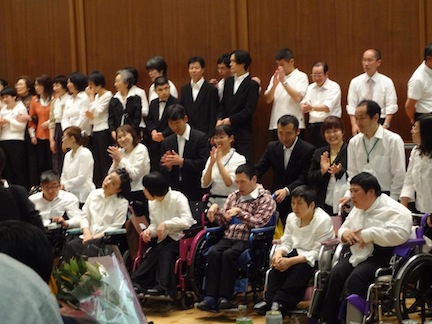
Last night I saw a concert at Carnegie Hall given by the Hearts and Eyes Choir ( ゆきわりそう合唱団 or Yukiwariso gasshoudan). This choir was established in 1990 by founder Hiroyo Ubayama, who was on hand to offer her greetings to the audience. It is composed of members with physical and mental disabilities, and the origin of its name is because the choir “shares its dreams and expresses its joy with its hearts and eyes.” They travel the world performing with the motto “we will all be sisters and brothers.” This was their second time on stage at Carnegie Hall, following their debut performance back in 2000.
They were joined by local choral groups as well as featured singers, and the pieces chosen were Rhapsody for Orchestra, Four Seasons of Old Home and Beethoven’s Symphony No. 9 in D Minor. Happy Doll founder Nozomi Terao was the MC, and during intermission collections Read More
JQ Magazine: COBU Gives Sakura Matsuri Season a Beat
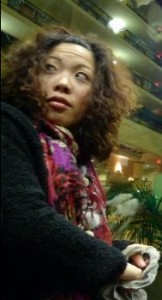
Takae Kawabe, a member of the all-female New York City-based taiko group COBU. (Courtesy of Takae Kawabe)
By Kirsten Phillips (Niigata-ken, 2005-2008) for JQ magazine. Kirsten is a native New Yorker and currently works as a teacher for the New York Board of Education.
Sakura matsuri season is upon us. For JET returnees, this time of year hearkens back to picnics with friends or students. Copious amounts of alcohol under the pink shower of blossoms and maneuvering through crowded lines of vendors celebrating the coming of spring. Sakura season also brings out the finest Japanese talent in New York and no event worth mentioning would be whole without the beating heart of COBU.
You haven’t been following COBU around like a bloodhound? Shame on you. Don’t even know what a COBU is? Double shame on you. Fortunately, oneesan is here to clue you in.
Spearheaded by artist and visionary Yako Miyamoto, COBU is more of a statement in taiko than a collaboration. We are heard. We are seen. We are felt. We are here. A handful of iron women play tirelessly in perfect sync. A little humor, an appropriate smattering of sexy and a metric ton of showmanship make COBU a delight for audiences across the tri-state area.
This year’s Branch Brook Park performance in New Jersey was a staggering hit by COBU, showcasing the talent of their following, or deshi. Upstage, COBU performing members Micro Fukuyama and Haruna Hisada kept time and loudly cheered on the fledgling members as they demonstrated some of COBU’S trademark choreography and pulsing patterns. If you have ever witnessed a COBU show before, it’s easy to become dazzled by the performing members, but this showcase invited audiences to the notion that, hey, they can be a part of this rhythm, too.
JET alum Arthur Migliazza plays the Boogie Stomp
Just learned about a talented JET alum musician via the Pacific Northwest JETAA Facebook group–boogie woogie and blues piano player Arthur Migliazza. Have a look and a listen:
Justin’s Japan: Nippon in New York – From ‘Edo Pop’ to ‘Poppy Hill’
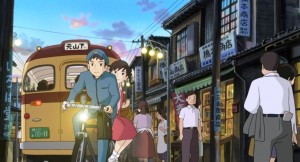
“From Up on Poppy Hill,” the latest film from Studio Ghibli, premieres in New York March 16. (©2011 Chizuru Takahashi/Tetsuro Sayama/GNDHDDT)
By JQ magazine editor Justin Tedaldi (CIR Kobe-shi, 2001-02) for Examiner.com. Visit his Japanese culture page here for related stories.
Tucked between Oscar and cherry blossom season, March offers an unmissable array of concerts, performances and film premieres, along with a special gathering to mark the two-year anniversary of the Tohoku earthquake and tsunami.
This month’s highlights include:
Sunday, March 3, 6:45 p.m.
Exploring the Road of Shamisen – Koto Workshop and Concert
Still Mind Zendo, 37 West 17th Street
$15 advance, $18 at the door
For reservations, email contact[at]marcreation.com or call 917-400-9362
In the latest workshop of the Spring Traditional Japanese Musical Instrument Series, shamisen specialist Yoko Reikano Kimura will demonstrate the vast 400 years of shamisen repertoire and explore the infinite possibilities of the instrument. Shamisen was brought to Japan through the Silk Road and since then it was popularized among samurai to ordinary citizens. But in today’s cosmopolitan age, new shamisen music continues to thrive.
March 6-9
The Bach Variations: Bach and Mendelssohn
Avery Fisher Hall, 10 Lincoln Center Plaza
$41-$123
In its first-ever Bach Festival, a kaleidoscopic three-week celebration of the depth and breadth the man the New York Times named the greatest composer of all time, Kobe-born conductor and harpsichordist Masaaki Suzuki leads five vocalists along with his own Bach Colleguim Japan and Yale Schola Cantorum with his own unique approach, combining his perspective with the virtuosity of the New York Philharmonic. On the program are Bach’s “Motet No. 1: Singet dem Herrn” and “Magnificat,” along with Mendelssohn’s :Magnificat in D Major” and “Christus.”
March 9-June 9
Edo Pop: The Graphic Impact of Japanese Prints
Japan Society, 333 East 47th Street
$12 general admission, $10 students and seniors, Japan Society members and children under 16 free
Edo Pop playfully juxtaposes classic ukiyo-e prints from such masters as Katsushika Hokusai and Utagawa Hiroshige with contemporary works inspired by these artists and their works. Delve into alluring worlds created by the power of Edo period and contemporary popular culture in which change is the only constant. Organized by the Minneapolis Institute of Arts, with the contemporary art selections curated for the New York presentation by Miwako Tezuka, Ph.D., Director, Japan Society Gallery.
For the complete story, click here.
Justin’s Japan: Japan Society Presents 15th Contemporary Dance Showcase: Japan + East Asia
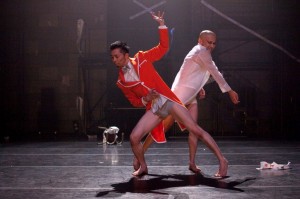
From Tokyo, “Misshitsu: Secret Honey Room,” created and performed collaboratively by Makotocluv founder Makoto Enda (in orange) and former Dairakudakan dancer Kumotaro Mukai (in white), has its North American premiere at Japan Society of New York Jan. 11-12. (Hideto Maezawa)
By JQ magazine editor Justin Tedaldi (CIR Kobe-shi, 2001-02) for Examiner.com. Visit his Japanese culture page here for related stories.
Japan Society swings into the new year with two nights of its upcoming 15th Contemporary Dance Showcase: Japan + East Asia showcase from Jan. 11-12. This year’s program features four North American premieres.
Since the inception of the Performing Arts Program in 1953, Japan Society has introduced more than 600 of Japan’s finest performing arts to an extensive American audience. The program also commissions new works to non-Japanese artists, produces national tours, organizes residency programs for American and Japanese artists and develops and distributes educational programs. Originally America’s leading platform for the introduction of Japanese choreographers and companies, the Dance Showcase has expanded to include artists and works of international acclaim from the broader East Asian region.
From Tokyo comes the U.S. premiere of post-post-post butoh Misshitsu: Secret Honey Room – Duo Version, created and performed collaboratively by Makotocluv founder Makoto Enda and former Dairakudakan dancer Kumotaro Mukai, following a world premiere at Setagaya Public Theatre/Theatre Tram in Tokyo in August 2012. Formed in 2001, Makotocluv appeared at Japan Society in 2008 and was hailed by the New York Times as “wonderfully fluent in the language of the theater.” Misshitsu: Secret Honey Room marks Mukai and Enda’s first collaboration in 15 years.
For the complete story, click here.
JQ Magazine: Concert Review – ‘The Legend of Zelda: Symphony of the Goddesses’
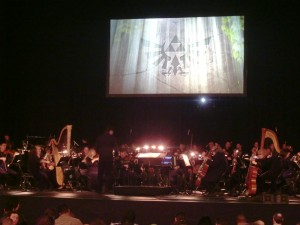
“There was so much attention paid to the nuance, so much consideration given to the fans, that the show became a kind of homage to both the franchise’s legacy and to every avid gamer whose collective fealty raised Zelda into one of the highest echelons of video game lore.” (Preston Hatfield)
By Preston Hatfield (Yamanashi-ken, 2009-10) for JQ magazine. Preston moved from San Francisco to New York City in January 2012 and is now accepting submissions from people who want to be his friend. Abduct him from his house in the middle of the night, or find him on Facebook and ask about his JET blog in which he details his exploits and misadventures in that crazy Land of the Rising Sun we all love.
If life is one ongoing adventure and each day is its own side quest, then several days ago the already labyrinthine halls beneath Madison Square Garden were not those of a theater but a dungeon, and the spirited host of attendees was nothing short of raiders in pursuit of plunder. Their coveted treasure on this magical evening of Nov. 28 was The Legend of Zelda: Symphony of the Goddesses from Jason Michael Paul Productions. Wielding the baton like her own personal Master Sword (or, as was the case at the onset of the Wind Waker movement, an actual replica of the Wind Waker), conductor Eimear Noone led the Orchestra of St. Luke’s into an epic musical campaign that toured across Hyrule and the 16 games in Zelda’s renowned platform, which is currently celebrating 25 years since its American debut on the original 8-bit Nintendo Entertainment System.
The evening commenced with a rousing overture in the form of “The Legend of Zelda Medley” before embarking a four-part movement that began with the crowd favorite Ocarina of Time, and concluded with A Link to the Past, the game where many of the now iconic Zelda themes first premiered. Each movement in this symphonic journey—this Tour de Triforce, if you will—began at the beginning of each game and proceeded to tell the familiar tales of heroism and mystic wonder, transitioning almost fairylike from one key moment to the next, as large screens over the orchestra showed in-game footage for context and intermittently focused on soloists and the choir.

Maynard Plant, second from left: “I really do think it is important to learn more than one language. Not only for the obvious convenience of communication, but for the enrichment of understanding of other cultures as well. Language really is the only gateway into understanding another person’s psyche and culture.” (Courtesy of Edward Entertainment Group)
By Preston Hatfield (Yamanashi-ken, 2009-10) for JQ magazine. Preston moved from San Francisco to New York City in January 2012 and is now accepting submissions from people who want to be his friend. Abduct him from his house in the middle of the night, or find him on Facebook and ask about his JET blog in which he details his exploits and misadventures in that crazy Land of the Rising Sun we all love.
Multinational pop rockers Monkey Majik are teaming up with shamisen heroes the Yoshida Brothers, the duo known for their traditional sound and pluck, for a three-date North American tour that kicks off Nov. 14 at Manhattan’s Marlin Room at Webster Hall, followed by the Mod Club in Toronto Nov. 18 and the National Arts Centre in Ottawa Nov. 20.
Monkey Majik was founded by Maynard Plant (Aomori-ken, 1997-2000), a native of Ottawa, Canada, while he was teaching English in Sendai on the JET Program. Known for a having a fun and versatile style of music, the band first earned mainstream attention in 2006 for their singles “Fly” and “Around the World,” and have since collaborated with other Japanese groups like SEAMO, m-flo, Bennie K, and the Yoshida Brothers.
In this exclusive JQ interview, the versatile vocalist and guitarist discusses the band’s origins, his own relationship with music, and his sense of home and community in Sendai, which is still recovering from the devastation caused by the 3/11 earthquake and tsunami.
Which came first: the love of music or Japanese culture, and how has the one influenced and supported the other since you came to Japan?
I probably first took interest in Japan when I was about 10 years old or so when I visited Expo 86 in Vancouver, Canada. My interest in music also started at an early age. Most of my family is musical, so it always came natural. Certainly since arriving in Japan about 15 years ago, my musical interests have changed. The Japanese music scene is incredibly diverse and different from the Western scene. The sound is very unique and [it] has had a deep effect on our music.
It’s funny, many ALTs in Japan feel like rock stars, but you actually became a rock star. What was it like going from small time notoriety and fame at your school, to becoming famous on a national level for your musicianship?
It didn’t happen overnight, so I suppose I never took notice. It’s a lot like learning Japanese—you don’t just wake up fluent one day. Success is born out of hard work and commitment. Regardless of where you live, the same elements come into play.
How did the current band members come together? Were you friends before you started collaborating professionally? How have each of you influenced Monkey Majik’s sound, style, and group dynamic?
I put the current band together after most of the original members quit in 2000. I first called my younger brother Blaise, and within a couple of months we found Tax (Kikuchi Takuya). It was around 2005 that our original bassist Misao Urushizaka quit. We then recruited Dick (Hideki Mori). It’s difficult to say if the friendship came before membership, but one thing is certain now: we wouldn’t be doing this if we hadn’t become best friends. We have a lot of respect for each other and all [band] decisions are made together.
Roland Kelts Praises the Who’s Pete Townshend in ‘The New Yorker’

Roland Kelts, left: “When I published my first book, Japanamerica, about the odd synchronicity between two societies, Japanese and American, at once at great odds and suddenly allies, my publisher asked me to send the book to Pete Townshend. He had asked for it, why not give it to him?”
Courtesy of JETAA Northern California’s Mark Frey (Kumamoto-ken, 2002-06):
In a new article by JET alum Roland Kelts (Osaka-shi, 1998-99) on Pete Townshend in The New Yorker, Kelts references his book Japanamerica—of which Townshend said “I love that book!” to JQ magazine editor Justin Tedaldi at an NYC signing yesterday for his new memoir Who I Am—at the end of the article and offers some thoughts contrasting the experience of artists in the U.K. and Japan after World War II.
I first met Pete Townshend fifteen years ago in a modest London hotel suite. I was there with my friend Larry David Smith to interview Townshend for Smith’s book, “The Minstrel’s Dilemma.” We were already seated inside when I looked out the first-floor window and saw Townshend pulling into the parking lot.
He arrived alone, sans entourage or fanfare, driving himself in a gray Mercedes station wagon. Minutes later, the knob on the suite door rattled and shook. I stood, thinking that it might be a member of the hotel staff and wondering if I should turn the knob from our side. There was a pause, then more rattling, then the door swung open and Townshend burst through, eyes wide with exertion. He had apparently been trying to pull when he should have pushed.
We were scheduled to meet for two hours, but Townshend was unstoppable, regaling us not with stories of rock debauchery, but a stream of complex, sometimes half-formed ideas about popular culture, history, and human psychology. We were told not to ask him about his failing marriage; he immediately addressed it, confessing to a jolt of sadness while shaving that morning. “Don’t mention Keith Moon,” wrote his personal assistant via fax. “I never properly mourned for Keith,” he soon said, unprompted, and through tears.
For the complete story, click here.
Justin’s Japan: NYC Gives B’z an A at Best Buy Theater
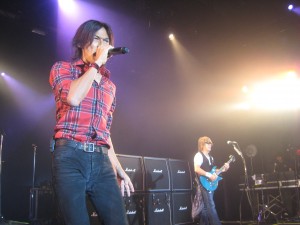
Koshi Inaba, left, and Tak Matsumoto of B’z played a sold out show at New York’s Best Buy Theater Sept. 30, 2012. (Justin Tedaldi)
By JQ magazine editor Justin Tedaldi (CIR Kobe-shi, 2001-02) for Examiner.com. Visit his Japanese culture page here for related stories.
“You’re not going to stand there the whole time, are you?” a thirtysomething asks me in Japanese from behind the photo pit barrier.
I tell her that I wouldn’t be much of a rock photographer if I stood still the whole time.
“Good,” she says, her face all business. “Because we lined up for this from yesterday morning. So please try to keep your head down, because it’s in my way.”
Welcome to the Best Buy Theater in Manhattan, which drew a sold out Sunday crowd of over 2,000 on Sept. 30 for the New York concert debut of B’z, Japan’s all-time biggest band. Since 1988, Tak Matsumoto and Koshi Inaba have sold over 80 million records, and hold an untouchable record for consecutive number one singles in their native land (46 and counting). A colossal achievement in music, to be sure, but how would the rockers be received on this, their first-ever coast to coast North American tour?
For the complete story, click here.
For Justin’s September 2012 interview with Tak and Koshi, click here.
Justin’s Japan: Interview with Tak Matsumoto and Koshi Inaba of B’z on the Live-Gym 2012 Tour

Tak Matsumoto, left: “This tour is going to be the fourth tour in the U.S. for B’z. I always love to play in the U.S., and I felt we should release English songs for the American audiences. The show will be a mix of both Japanese and English.” (Vermillion)
By JQ magazine editor Justin Tedaldi (CIR Kobe-shi, 2001-02) for Examiner.com. Visit his Japanese culture page here for related stories.
The most successful group in Japanese history, B’z have sold 80 million records since their 1988 debut, and also have released a staggering 46 consecutive number one singles. Comprised of Grammy-winning guitarist Tak Matsumoto and ace vocalist Koshi Inaba, the rock duo has flirted with American success in the past, launching three of their Live-Gym West Coast tours in the last decade.
Now, B’z is ready for a full-scale American invasion, launching their first-ever national tour beginning in San Francisco Sept. 17 and hitting New York’s Best Buy Theater Sept. 30. At the same time, the band is promoting its debut English-language digital EP entitled B’z, which features five of the stadium act’s biggest hits made for a whole new audience.
In this exclusive interview, I caught up with Tak and Koshi on why the band waited until now to do a coast-to-coast tour, their experience working with other rock luminaries like Aerosmith and Linkin Park, and the plans in motion for the band’s 25th anniversary next year.
Let’s start with the basics. How did the band get its name?
Tak: I don’t remember exactly. We probably thought we needed to have a simple name that was easy to memorize.
Koshi: We wanted a short name—like a code. At first, it was AZ, which came from an A to Z kind of meaning, but we didn’t like how it was pronounced. Then we changed it to B to Z, and liked how it sounded.
Why has B’z decided to finally play New York now?
Tak: I don’t know exactly why it took so long, but I’ve been waiting to perform there. I’m really looking forward to it.
Koshi: When we started performing in the U.S., most of our dates were on the West Coast. We weren’t familiar enough with New York to have a show there.
Tell us about the other musicians you’re performing with on this tour.
Tak: Takanobu Masuda is on keyboards. He’s my old friend, and has been performing with B’z for 20 years. Shane Gaalaas is on drums. He’s played with Michael Schenker, Yngwie Malmsteen and many others. He also has his own band, Cosmosquad. Barry Sparks is on bass. He also played with Michael and Yngwie, along with Ted Nugent, UFO and the Scorpions as well. Yoshinobu Ohga is on guitar. He was on our last tour of the U.S. I’m supported by his perfect harmony.
Koshi: Ohga joined last year. Everyone else has been touring with B’z for a long time, and they’re all great.
What can we look forward to at these shows?
Tak: We are going to the East Coast for the first time, but this tour is going to be the fourth tour in the U.S. for B’z. I always love to play in the U.S., and I felt we should release English songs for the American audiences. The show will be a mix of both Japanese and English.
Koshi: We’re looking forward to the U.S. audience hearing our new English songs. You might sweat a lot at our show, but you’ll enjoy it!
Is this new EP part of a plan to release a full English-language album in the future?
Tak: I hope so.
For the complete interview, click here.
Justin’s Japan: Nippon in New York — B’z, Books, Sake Tastings and Michael Jackson in Yokohama

B’z, the biggest-selling musicians in Japanese history, will make their New York debut at Best Buy Theater Sept. 30. (Courtesy of Best Buy Theater)
By JQ magazine editor Justin Tedaldi (CIR Kobe-shi, 2001-02) for Examiner.com. Visit his Japanese culture page here for related stories.
After you’ve rested up from Labor Day weekend, enjoy the sights, sounds and tastes of Japan with a whole month’s worth of events, activities and products from musicians to authors to restaurants. It’s all happening here as we welcome another autumn in New York.
Tuesday, Sept. 4, 6:00 p.m.-8:00 p.m.
Oze no Yukidoke from Ryujin Shuzo Sake tasting
Sakaya
324 East 9th Street
Hailing from Gunma prefecture, Oze-no-Yukidoke is a well-refined sake that is widely considered to be one of the finest sakes available. Join Mr. Hideki Horikoshi, the head sake brewer of Ryujin Shuzo, for his his handmade signature sake, Oze no Yukidoke Junmai Daiginjo, as well as Ohkarakuchi Junmai. Purchasers will receive a lacquered sake cup as a free gift!
Sunday, Sept. 9, 1:00 p.m.
Cultural Resource – Contemporay Music by Japanese Composers/Musicians
Scandinavia House
58 Park Avenue
“The influences of ethnicity on the musical idioms of contemporary composers” is the research subject of Akiko Asai, Visiting Scholar at New York University. This concert is held as a part of her research project and a wrap-up of her research term at NYU and features Japanese composers and their works. The audience will be able to not only meet these artists’ creativities but also listen to the result of their research through the identical sound of accordion. Tomomi Ota, who will play their pieces, is a one of the promising performers who can show the audience different perspectives vividly.
For the complete story, click here.

